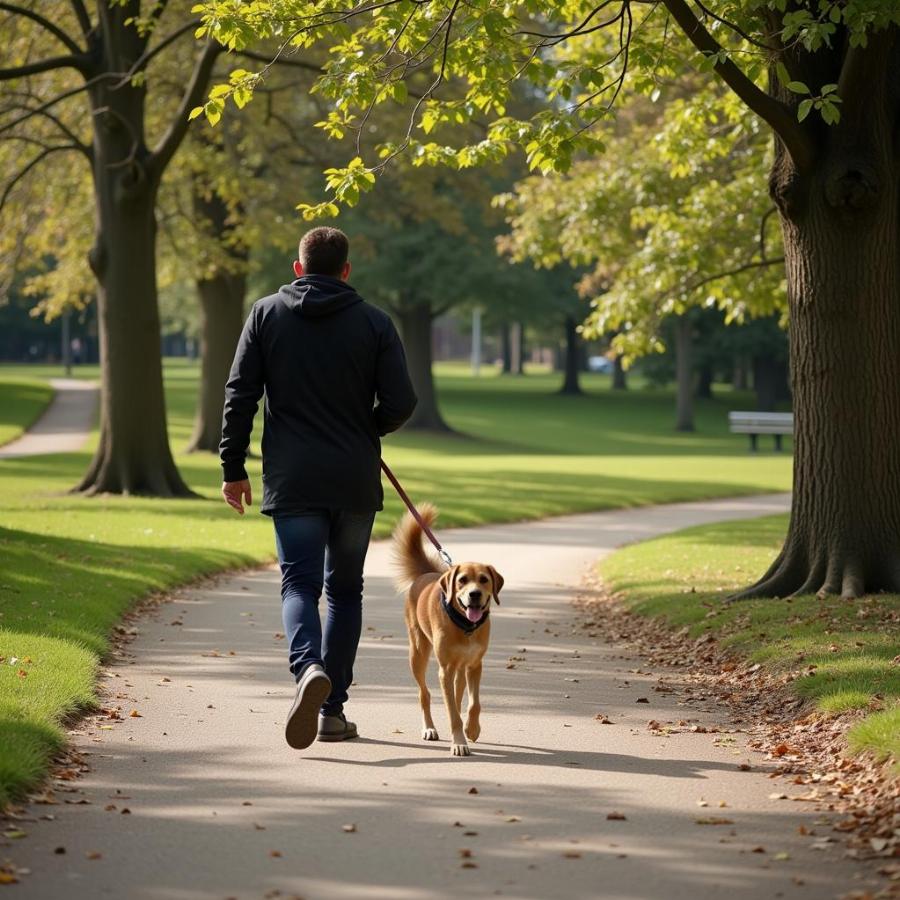Dealing with a dog that barks excessively at people can be a frustrating experience for any owner. It’s important to remember that barking is a natural canine behavior, often used for communication. However, when barking becomes excessive, it can be disruptive and indicate underlying issues. This comprehensive guide explores proven strategies to help you understand why your furry friend might be barking at people and provides practical tips on how to curb this behavior.
Understanding the Root of the Problem: Why Does My Dog Bark at People?
Before jumping into solutions, it’s crucial to identify the reasons behind your dog’s barking. Dogs bark for various reasons, and understanding the motivation behind their vocalizations is key to addressing the issue effectively.
- Territorial Barking: Dogs are naturally territorial and may bark at people approaching their perceived territory, such as your home, yard, or even car.
- Fear or Anxiety: Barking can be a fear response in dogs. They may bark at unfamiliar people due to feeling scared or threatened.
- Lack of Socialization: Dogs that haven’t been properly socialized during puppyhood might be more prone to barking at strangers due to unfamiliarity and fear.
- Attention-Seeking: Some dogs bark at people to get attention, whether it’s positive, like petting, or negative, like being told off.
- Excitement or Playfulness: Barking can also be a sign of excitement, especially when your dog encounters people they know and enjoy playing with.
Effective Techniques to Stop Your Dog from Barking at People
Now that you have a better understanding of potential triggers, let’s dive into the practical strategies you can implement to curb your dog’s barking:
1. Positive Reinforcement: Reward the Silence
Positive reinforcement is a powerful tool in dog training. Instead of punishing barking, focus on rewarding your dog when they remain quiet in the presence of people. Here’s how:
- Start Small: Begin training in a controlled environment with familiar people.
- Mark and Reward: As soon as your dog sees a person and remains silent, mark the behavior with a verbal cue like “yes” or a clicker. Immediately follow this with a high-value treat.
- Gradually Increase Distractions: As your dog progresses, gradually introduce more challenging situations, such as having strangers approach or practicing in busier environments.
2. Desensitization: Gradual Introduction
Desensitization involves gradually exposing your dog to the stimulus that triggers their barking—in this case, people—in a controlled manner. This helps them become accustomed to the presence of people without feeling threatened.
- Distance and Control: Begin by keeping a safe distance from people. Have your dog sit or lie down and reward them for remaining calm.
- Gradual Approach: Slowly decrease the distance as your dog shows signs of relaxation. If they start barking, increase the distance again.
3. Redirect Their Attention
When your dog starts barking at a person, redirect their attention to a more desirable behavior. This could involve:
- Teaching the “Look at Me” Command: This command is invaluable for redirecting your dog’s focus. Practice it regularly, and when they begin barking, use the command and reward them for making eye contact.
- Engaging in Play: If your dog barks out of excitement, redirect their energy into a fun game of fetch or tug-of-war.
- Offering a Chew Toy: Provide your dog with a long-lasting chew toy to keep them occupied and distracted when people are around.
4. Address Underlying Anxiety (If Applicable)
If fear or anxiety fuels your dog’s barking, consult with a veterinarian or a certified dog behaviorist. They can help identify potential underlying issues and recommend appropriate solutions such as:
- Behavioral Modification Techniques: A professional can guide you on specific techniques to manage and modify your dog’s fear-based behaviors.
- Medication: In some cases, anti-anxiety medication may be recommended to help your dog cope with their fear.
5. Consistency and Patience are Key
Remember that training takes time and consistency. Be patient with your dog and celebrate their progress. Avoid punishment-based methods as they can worsen anxiety and damage your bond.
 Dog Owner Walking with Their Dog
Dog Owner Walking with Their Dog
Conclusion: A Quieter and Happier Life for You and Your Dog
Addressing excessive barking requires patience, understanding, and a commitment to positive reinforcement techniques. By identifying the root cause of the barking and implementing the strategies outlined in this guide, you can help your canine companion become more comfortable and less reactive around people, leading to a more peaceful and enjoyable experience for both of you.
FAQs: Common Questions About Dogs Barking at People
Q: Is it ever okay for my dog to bark at people?
A: Some barking is normal, like alerting you to someone at the door. However, excessive or aggressive barking needs to be addressed.
Q: What if nothing seems to work?
A: If you’ve tried these tips consistently and haven’t seen improvement, it’s essential to consult a certified dog behaviorist or veterinarian. They can assess the situation and provide tailored guidance.
Looking for More Helpful Tips?
Check out these other insightful articles on Beaut Dogs:
About Beaut Dogs
Beaut Dogs is your trusted source for all things dog-related. We’re passionate about providing dog lovers with expert advice and reliable information to help you build a stronger bond with your furry friend. For personalized support, contact us at [email protected].